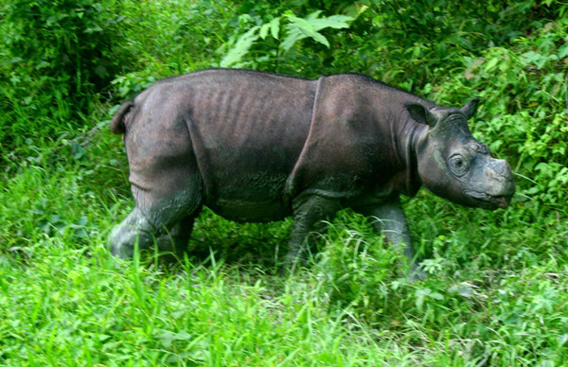
Tam, a male Sumatran rhino is kept in semi-captivity in Borneo with hopes to mate him with a female. The Sumatran rhinos on Borneo are actually a unique subspecies, dubbed the Borneo rhino, they are the world’s smallest.Photo by: Jeremy Hance.
Malaysia must take immediate action to prevent the extinction of the handful of rhinos that survive on the island of Borneo, says a coalition of environmental groups.
In a statement issued today, the Borneo Rhino Alliance, Land Empowerment Animals People, Resources Stewardship Consultants, the Malaysian Nature Society, TRAFFIC Southeast Asia, and WWF-Malaysia said it is too late to save Malaysia’s rhinos by simply leaving them to on their own scattered across remaining forest areas. Instead, the time has come for direct intervention, including translocating wild rhinos from “existing small, isolated or threatened forest patches into semi-in situ captive breeding programs” and improving protection and monitoring in areas that have established breeding facilities or are known to have relatively high population densities. The conservationists say that increasing scarcity means the biggest threat to Malaysian rhinos today is an inability to reproduce due to low mate encounter rates and skewed sex ratios.
“Protection of the remaining wild rhinos and their habitat are necessary but insufficient measures to prevent the species extinction,” the groups state, noting that urgency has been added by Vietnam’s announcement last month that its rhino subspecies is now extinct. Peninsular Malaysia once has the same species of rhino, but it went extinct in the 1930s.
“We surely do not want Malaysia to have to announce in a couple of decades from now news similar to that from Vietnam last month. Let’s recognize that efforts to promote the survival of the Sumatran rhinoceros ought to be made a national conservation priority.”
The groups are calling for $1.2 million in funding to implement a plan to save rhinos in four priority areas in Sabah and Indonesia’s Sumatra island.
The text of the appeal appears below.
Extinction of Vietnam rhinoceros and implications for Malaysia
The recent news of the extinction of the Javan rhinoceros on mainland Asia, with the death by poaching of the last remaining female in Vietnam in 2010, prompts us to draw attention to two implications for Malaysia. Firstly, this same kind of rhino went extinct in Malaysia in the 1930s. Thus, what seems at first to be only a local loss from Peninsular Malaysia has transformed into a global extinction of a unique population of Javan rhinoceros. It is now up to Indonesia to save the last remaining population of the species, on the island of Java. Secondly, there is another species of Asian rhinoceros of concern nearer to home. This is also an extremely endangered species, commonly known as the Sumatran rhinoceros, previously widespread in Asia but now confirmed to occur only in Indonesia and Malaysia.
Despite dedicated efforts to protect this species from poaching over the past few decades, within protected areas in Sumatra, Peninsular Malaysia and Sabah, numbers have continued to decline. Most specialists close to the situation now believe that habitat loss and poaching no longer represent the major threats to the survival of this rhino. Instead, numbers are so very low that factors associated with low numbers, including inability to find a fertile mate, pathology of the reproductive organs in females resulting in no pregnancies, inbreeding and skewed sex ratio, mean that for many years, rhino death rate has been exceeding birth rate. If this is so, then protection of the remaining wild rhinos and their habitat are necessary but insufficient measures to prevent the species extinction.
In a paper titled “Now or never: what will it take to save the Sumatran rhinoceros Dicerorhinus sumatrensis from extinction?” published in the international conservation journal Oryx earlier in 2011, Ahmad Zafir and his colleagues in WWF-Malaysia, Sabah Wildlife Department and Yayasan Badak Indonesia, wrote the following: “Recent data from governments, NGOs and researchers indicate that the global Sumatran rhino population could be as low as 216, a decline from about 320 estimated in 1995. Based on lessons learnt and expert opinions we call on decision makers involved in Sumatran rhino conservation to focus on a two-pronged approach for conservation of the species: (1) the translocation of wild rhinos from existing small, isolated or threatened forest patches into semi-in situ captive breeding programmes, and (2) a concomitant enhancement of protection and monitoring capacities in priority areas that have established these breeding facilities or have recorded relatively high population estimates and track encounter rates. At least USD 1.2 million is required to implement this two-pronged strategy annually in four priority areas: Bukit Barisan Selatan and Way Kambas National Parks on Sumatra, and Danum Valley Conservation Area and Tabin Wildlife Reserve on Sabah.” The Borneo Rhino Sanctuary programme is already underway in Sabah, based on those two approaches, and implemented by Sabah Wildlife Department with assistance from other agencies including Institute for Zoo and Wildlife Research (Berlin), Yayasan Sime Darby, WWF-Malaysia and Borneo Rhino Alliance, a recently established Malaysian NGO dedicated to saving the rhinos in Sabah. A similar programme has been underway in Indonesia for more than a decade.
The extinction of the Vietnam rhino suggests that leaving rhinos in the wild to be poached or die of old age is no longer an adequate approach. Instead, the Indonesian and Malaysian approach for the Sumatran rhinoceros is most likely now the only way forward to prevent the extinction of this species. Why bother to save the species? The argument is ethical, not economic. Fossils show that something very similar to this form of rhino has existed for about 20 million years, and we may be only a decade or two away from its extinction if no active interventions are made. Now that we know the situation, we ought to try to prevent extinction before that opportunity is lost. Is it worth the money? Ahmad Zafir and colleagues put that question in context, noting in their paper that the annual cost of running the ongoing programmes in Sumatra and Sabah is equivalent to the amount paid at an auction in USA in 2010 for a 1939 edition of a Batman comic book.
We surely do not want Malaysia to have to announce in a couple of decades from now news similar to that from Vietnam last month. Let’s recognise that efforts to promote the survival of the Sumatran rhinoceros ought to be made a national conservation priority.
Related articles
Vietnamese rhino goes extinct

(10/25/2011) In 2009 poachers shot and killed the world’s last Vietnamese rhinoceros (Rhinoceros sondaicus annamiticus), a subspecies of the Javan rhino, confirms a report from International Rhino Foundation (IRF) and the World Wide Fund for Nature (WWF). The Vietnamese rhino was the last Javan rhino to survive on the Asian mainland and the second subspecies to vanish, following the extinction of the Indian Javan rhino (rhinoceros sondaicus inermis). The Javan rhino is the world’s most imperiled rhino species with now only around 50 individuals surviving in a single park on its namesake island in Indonesia.
How do we save the Sumatran rhino?

(06/06/2011) Some conservation challenges are more daunting than others. For example, how do you save a species that has been whittled down to just a couple hundred individuals; still faces threats such as deforestation, poaching and trapping; is notoriously difficult to breed in captivity; and is losing precious time because surviving animals are so few and far-apart that simply finding one another—let alone mating and successfully bringing a baby into the world—is unlikely? This is the uphill task that faces conservationists scrambling to save the Sumatran rhino (Dicerorhinus sumatrensis). A new paper in Oryx, aptly named Now or never: what will it take to save the Sumatran rhinoceros Dicerorhinus sumatrensis from extinction? analyzes the conservation challenge, while putting forth a number of recommendations.